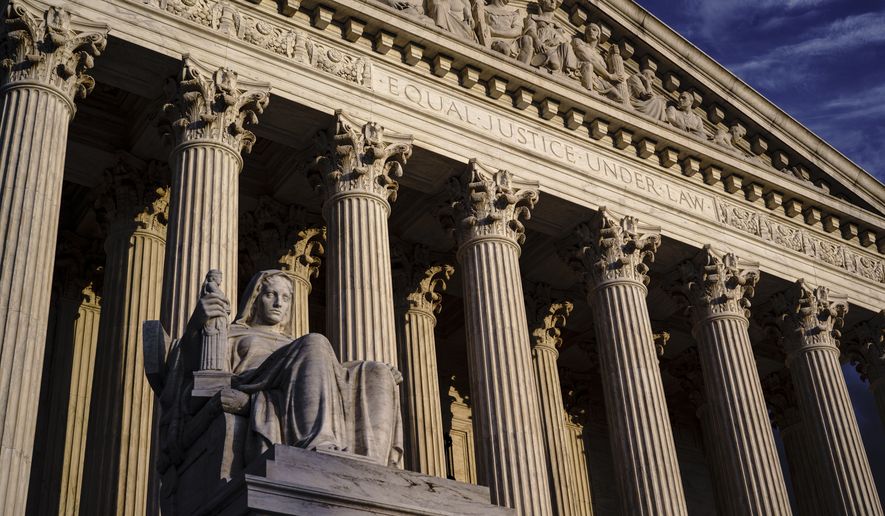OPINION:
Editor’s note: This is one in a series examining the Constitution and Federalist Papers in today’s America.
The Chevron doctrine is on a deathwatch.
Most of the attention in the recent Supreme Court decision striking the broad national vaccine mandate for big businesses was focused, naturally, on the effect of the decision on the 84 million people who would have been subject to the mandate. But the more lasting and material effect of the decision is the court majority’s emphasis on who interprets and decides the extent of agency authority.
For the 230 million American citizens not affected by the vaccine mandate, the good news is that the high court struck the Occupational Safety and Health Administration mandate primarily by addressing, obliquely, the flaws of the Chevron doctrine. That doctrine, first articulated by the Supreme Court in 1984 in Chevron v. NRDC, holds that the agency responsible for implementation of statutes is also empowered to interpret those statutes, provided that such interpretations are reasonable and defensible.
Consequently, federal courts defer to agencies for the interpretation of statutes within their expertise. If that seems like a problem, that’s because it is.
Apart from practical considerations — bureaucracies in all times, places and circumstances seek to expand their budget and authority — the Chevron doctrine vitiates the separation of powers embedded in the Constitution. If agencies can write law (through the mechanism of “interpreting” statutory construction), interpret the law and execute the law, then what’s the point of electing a Congress or empaneling a judiciary?
The big winner in NFIB v. Department of Labor is congressional authority. While it is not at all shocking that judges believe they should be interpreting laws (and accruing power and authority) rather than bureaucrats, the simple reality is that courts don’t have the time, expertise or patience to interpret the statutory provisions about which there are material questions. Dozens of new ones emerge almost every day as the regulatory state never sleeps.
In the absence of Chevron, agencies are going to have to defer to congressional legislative construction. In places where legislative construction does not exist, agencies will no longer be able to create the authority they want from whole cloth.
It is not accidental that the majority writing in NFIB started their decision by noting that: “OSHA has never before imposed such a mandate. Nor has Congress. Indeed, although Congress has enacted significant legislation addressing the COVID-19 pandemic, it has declined to enact any measure similar to what OSHA has promulgated here.”
In other words, Congress had a chance to address this very question and took a hard pass. The majority also made it clear that the statute that established OSHA required it to ensure “occupational safety” not to “regulate the hazards of daily life.”
The majority argued that congressional action — or inaction — means something. Even at this late date in the republic, the citizens’ elected representatives should be primary in the creation of laws and legal strictures. As Madison noted in Federalist 51: “In republican government the legislative authority, necessarily, predominates.”
In short, in the view of the majority, absent an express grant of authority from Congress, the agency — however it wants to interpret its organic statute — may not proceed.
The liberal side of the court is aware of the existential risk that this sort of thinking poses to the regulatory state. Justices Stephen Breyer, Sonia Sotomayor and Elena Kagan tried to flip the script by pointing out that the majority was trying to impose a limit on OSHA not found in its governing statute. In other words, their argument is that if legislation does not specifically prohibit something, an agency should be allowed to do it.
There is no conceivable way that yardstick could be used and separation of powers between the legislative and executive branches remain.
The issue of congressional grants of authority and agency deference will no doubt be repeated and expanded in other cases, especially in West Virginia v. EPA over Obama-era regulations addressing climate change, scheduled to be argued Feb. 28, and perhaps in a drug pricing case (of all things) that has already been argued (American Hospital Association v. Becerra).
The good news for those concerned about the wisdom of Chevron doctrine is that the regulatory state is busy every day providing grist for the mill. It is simply a matter of time until the doctrine is struck entirely or minimized and caveated to the point of meaninglessness.
That’s also good news for those who support the Constitution.
• Thomas Pyle is the president of the American Energy Alliance and the host of “The Unregulated” podcast.





Please read our comment policy before commenting.